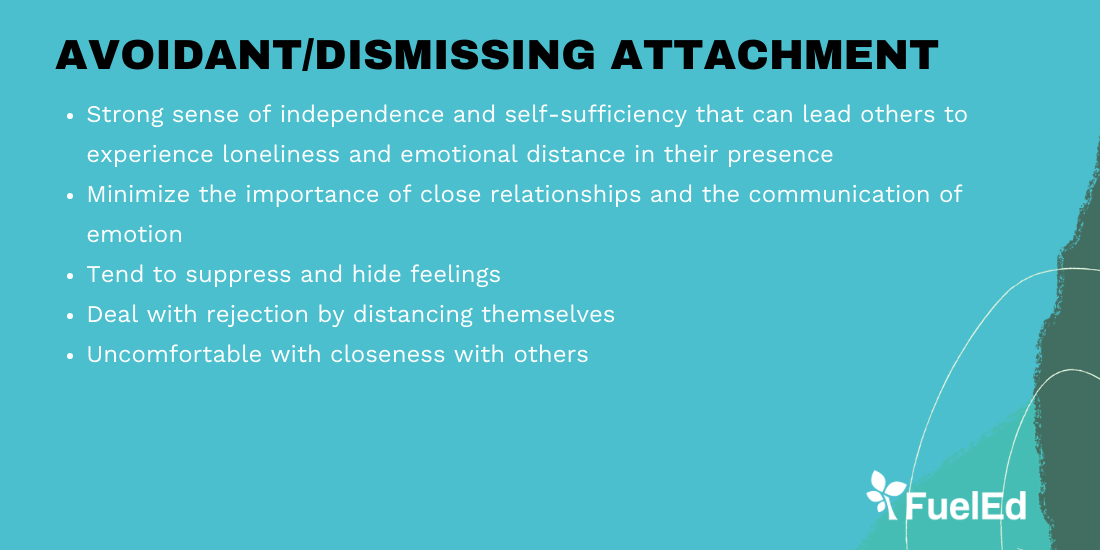Attachment Styles And Your Stress Response
A fascinating and still-developing body of research is revealing that how our body reacts to and copes with challenges is influenced by our early experiences in relationships. From disorganized attachment to secure attachment, we'll review how your body reacts.

How Adult Attachment Styles Impact Stress Response
A fascinating and still-developing body of research is revealing that our early attachment experiences shape the physiological systems that help us to regulate our stress reactions. In other words, how our body reacts to and copes with challenges is influenced by our early experiences in relationships. As we endure worldwide collective challenges in the COVID-19 pandemic, understanding how humans deal with stress has practical implications for how you adapt to and endure this experience. Identifying how your attachment style may impact your stress response can both increase your self-awareness and self-compassion and may also help you to identify new ways of regulating yourself. In addition, becoming aware of the spectrum of stress responses can help you to build empathy for others’ responses to stress and provide a pathway to conflict resolution and closer relationships.
If you are unfamiliar with attachment styles, see the below chart to orient yourself to your tendencies in attachment relationships.
An individual’s attachment style can provide insight into how they respond to stress. In short, your attachment style can influence:
- How you perceive stress and challenge.
- How you react to, and recover from, stress.
- The role that people and relationships play in your efforts to cope with stress.
- The strategies you use to cope with and adapt to, stress.
Check out our programs
LEARN MORESecure Attachment Under Stress
For those with a secure attachment style, their experience of fear, or threat detection, is modulated by perspective-taking. Their inherent trust in others mediates the fear response . and creates a protective cushion for how they perceive stress. This cushion allows the brain to select a solution-based approach rather than a no-solution approach, even in difficult or “impossible” situations. This inherent trust plays a powerful role in their sense of hope that future collaboration and relationships will get them through difficult situations., From a physiological standpoint, there is even evidence that just being near a loved one is enough to decrease the heart rate and return securely attached people to a state of calm.
For those with secure attachment, when faced with stress the message is something like “Together, we can do this” and the nervous system is calibrated more toward “We can” than “I can’t.”
Securely attached people often have a solutions-based approach to stress thanks to neural pathways that were developed to both react to, and bounce back from, stress. Sensitive early life interactions supported their brains to develop both a healthy and active response to input (i.e. not detached or unaware) but also the emotional security to recover more quickly from stress (i.e. calms down after being alarmed). In this way, secure attachment is like a fresh rubber band: you can stretch it out, but it snaps right back from tension.
For those with secure attachment, when faced with stress the message is something like “Together, we can do this” and the nervous system is calibrated more toward “We can” than “I can’t.”
In addition, because people with secure attachment are more likely to view others as resources (rather than threats) based on their brain’s early template of supportive and accepting relationships, they often have an easier time reaching out to others for help. This comfort with seeking help from others, combined with their ability to self-soothe, provides those with secure attachment with the ability to use both co-regulation strategies and self-regulation strategies to return to calm.
The securely attached person will experience “solutions” in abundance thanks to this ability to leverage both self and others as regulation strategies. This abundance builds upon itself since when we are calm our brain becomes more specialized in play, exploration, and creativity, all of which are essential ingredients for problem-solving
Signs of growth for Securely Attached people: One might measure progress toward developing secure attachment by looking at how they balance self-reliance with support from others. This could look like reaching out to a friend for support with an issue and then turning off their phone to have some quiet relaxation time.
Earned Secure Exercise: Take a moment to jot down all of the things you do to keep yourself emotionally regulated (your regulation resources). Underline or highlight the spaces where you find safety, consolation, regulation, and hope. Explicitly naming these can provide you with a roadmap, or guide, for solidifying your sense of safety in alarming moments. Since some of your resources likely involve relationships, take a moment to reach out and express gratitude for the people in your life.

Avoidant Attachment Under Stress
People with a history of avoidant attachment may perceive stress through a lens of minimization and independence. “I don’t need anyone” and “I’ve got to figure this out” are two phrases that might come to mind, and challenges (such as a global pandemic) may be perceived as simultaneously “not that bad” and their catastrophe to fix. People with avoidant attachment can even feel annoyed by others’ “overreaction” to the stress while at the same time experiencing the burden of responsibility to “keep it together” and “solve the problem”. In this way, stress and trauma for people with avoidant attachment are not approached through connection and collective resilience but rather through individualized determination. An avoidant attachment history might manifest in moments of stress as numbness, or lack of emotion, complimented by swift action to remedy the issue and keep things safe.
The message is something like, “Alone, I can do this,” and their nervous systems are calibrated toward high-energy mobilization. This reaction may feel productive and provide a semblance of control, but also often manifests in overworking and/or over-functioning. Close friends, colleagues, and relations of people with an avoidant attachment history might experience them as “fine”, strong, or indifferent. These sentiments can feel reinforcing and validating, but internally those with avoidant attachment will also likely experience little windows where their loneliness or exhaustion starts to catch up to them. The conflict of “I don’t need anyone” and “why does no one ever take care of me?” comes to the surface and can leave them with a deep desire to be able to rely on others as a resource during difficult times.

Signs of growth for Avoidant Attached people: For those with avoidant attachment, one sign of growth would be the ability to find little windows where you’re able to sit in the experience of loneliness or exhaustion and invite the desire to be able to rely on others as a resource during difficult times.
Earned Secure Exercise for Avoidant Attached people: For many people who identify with avoidant attachment, both reaching out AND receiving care can feel difficult. It is important to pace yourself with small challenges to experience more security in relationships.
Consider reaching out to a safe friend and simply letting them know one thing you feel and one thing you need. For example, a text message to a friend might say, “Hey, I’ve been feeling exhausted and down. I need some people time--can we grab a beer over Zoom?”
This is a simple step toward experiencing co-regulation in a secure relationship. Keep in mind that those with avoidant attachment will oftentimes subconsciously look to reinforce their internal narrative with outside evidence - “He couldn’t meet me today, I knew I was all alone. I shouldn’t have reached out in the first place.” Pick small, safe tests that are likely to succeed and don’t let a “not today” be another block in your Jenga stack of “no one is ever going to be there for me”..
Bring FuelEd to your school, district, or organization
SCHEDULE A CALLAnxious Attachment Under Stress:
For those with a history of anxious attachment, stressful events are often experienced through a lens of amplification. They can feel alarmed and overwhelmed by difficult situations and their perception is deeply impacted by the reactions of others around them.
Along with strong reactivity to stress, they may also find it difficult to “bounce back” from difficult situations, and they can experience sustained overwhelm and feelings of being “stuck” in crisis. It is also common for those with an anxious attachment history to depend on others for regulation - to feel calmer, safer, better - versus stopping to check-in and take care of themselves.
The message is, “I can’t do this alone.” There is a sense of both needing others while also being uncertain if they are worthy of the care they desire. This can create an experience of powerlessness or dependence in their relationships and a feeling of “half-safety” - like sleeping with one eye open. Similar to those with avoidant attachment they experience stress by mobilizing and living in this mobilized-anxious response can only last so long. These folks may find themselves burnt out or even angry in the face of prolonged stress while others may experience them as “amped-up”, clingy, or needy.
The message is, “I can’t do this alone.” There is a sense of both needing others while also being uncertain if they are worthy of the care they desire.
When their internal stress response “I can’t do this alone” and their external response “I need you to regulate me” meet the outside world - full of people with varied attachment styles and histories - the reactions they receive can leave them feeling misunderstood or abandoned by others.

Signs of growth for Anxiously Attached people:
Ultimately those with anxious attachment want to feel steady and more grounded in the face of challenge. Awareness - noticing the desire to feel steady and grounded would be the first step. Action - taking steps to gather resources that make you feel more steady and grounded.
Earned Secure Exercise for Anxiously Attached People: Take a moment to practice self-regulation. Simply check-in with your body and mind as a way to calm yourself. In a quiet place, close your eyes and ask yourself,
“What am I feeling? What am I needing?”
Take five minutes to listen to your feelings. Don’t get lost in thoughts but rather try and bring it back to what you are feeling. Name the feelings. Label them. You can even write them down.
Once you are in better touch with what you are feeling, identify a practical need to match each feeling. For example, if you’re feeling lonely maybe the need is a one-on-one conversation with your partner, or if you’re feeling anxious maybe the need is a brisk walk and fresh air.
Finally, gently turn your answers into statements of generosity, written as though you were speaking them to someone you love dearly. Name your feelings and needs as externalized statements of love and caring.
Statements like:
“You are exhausted, you need a full night of sleep” or
“You are overwhelmed, you need some help” makes space for you to honor your own needs.
Disorganized Attachment Under Stress:
For those with a disorganized attachment style, periods of stress and alarm can be particularly confusing. Because of their history, relationships, and life can feel scary and unpredictable and they may perceive stress through the lens of unreliability.
The message is, “I have to do this on my own, but I can’t possibly do this alone.” This creates a bind in which they both need to, and at the same time cannot rely on others to, help them regulate. Feeling stuck, without any course of action, a person with disorganized attachment can go to dissociating or “checking-out” from painful or uncomfortable experiences. While people of all attachment styles fall into unhealthy coping strategies, those with disorganized attachment may feel especially vulnerable to these when stressed.
If relationships do not feel accessible, and self-regulation isn’t ‘working”, they may find themselves trying to regulate through their environment (examples: excessive exercise or alcohol consumption).

Signs of growth for Disorganized Attached people: When stress peaks, the ability to start naming the desire to feel feelings without becoming overwhelmed or paralyzed is a move toward earned secure attachment. Many of these folks also have interpersonal instability or confusing relationships, so growth also looks like 1) an awareness that their relationships are insatiable and then 2) a desire for steady and dependable ones.
Earned Secure Exercise for Disorganized Attached people: A grounding practice to reconnect with your body in the present, the “now” can promote a sense of calm. If you notice yourself feeling especially distressed or “zoned,” energizing or calming sensory practices can be helpful.
Try this one. While taking slow breaths, hold a piece of ice while it melts. Watch the drips as they fall through your fingers. Experience the contrast between the feeling inside your hand and outside. Continue breathing as you watch and feel the ice melt in your hand.
Alternatively, this one you can do inconspicuously while doing dishes or in the bathroom. Run warm water in the faucet and run your hands under flow - feeling the water wash over them for five breaths. Then switch the water to cold for five breaths and notice how the change feels. Again, watch and feel as the water washes over your hands. You can alternate warm and cold a few times to find a moment in the “now” and focus on the physical experience of the water.
About the author
Kelley Munger
PhD, LPC, NCC
Kelley holds a BA in English from Auburn University, an MA in Teaching from Lee University, and an MA in Counseling Psychology from Covenant Seminary. She completed her PhD in Early Intervention and Special Education at the University of Oregon in 2019. Kelley is a researcher and licensed therapist working in the areas of trauma, adult attachment, special education, and human development. She is passionate about leveraging the power of relationships to promote developmental flourishing across the lifespan.
Kelley holds a BA in English from Auburn University, an MA in Teaching from Lee University, and an MA in Counseling Psychology from Covenant Seminary. She completed her PhD in Early Intervention and Special Education at the University of Oregon in 2019. Kelley is a researcher and licensed therapist working in the areas of trauma, adult attachment, special education, and human development. She is passionate about leveraging the power of relationships to promote developmental flourishing across the lifespan.




